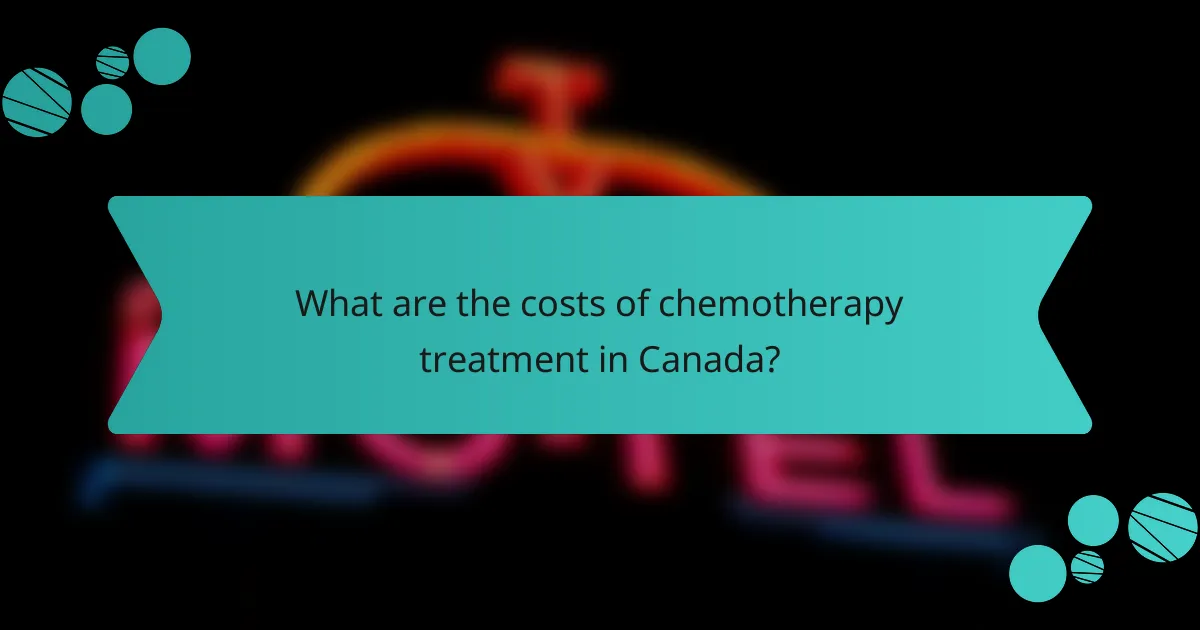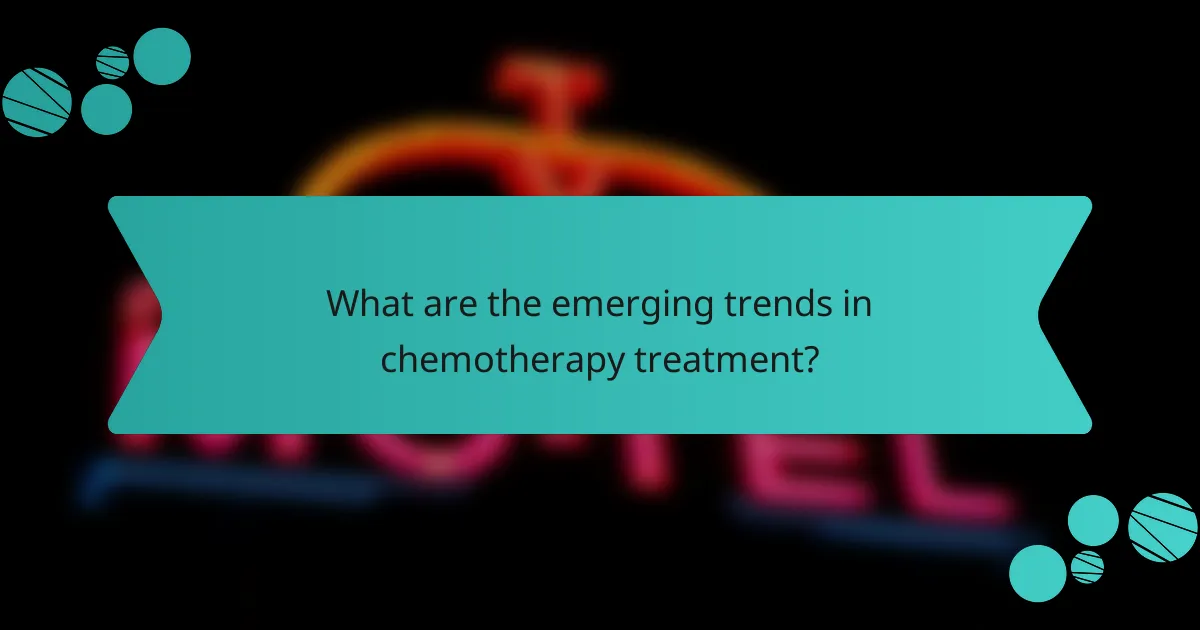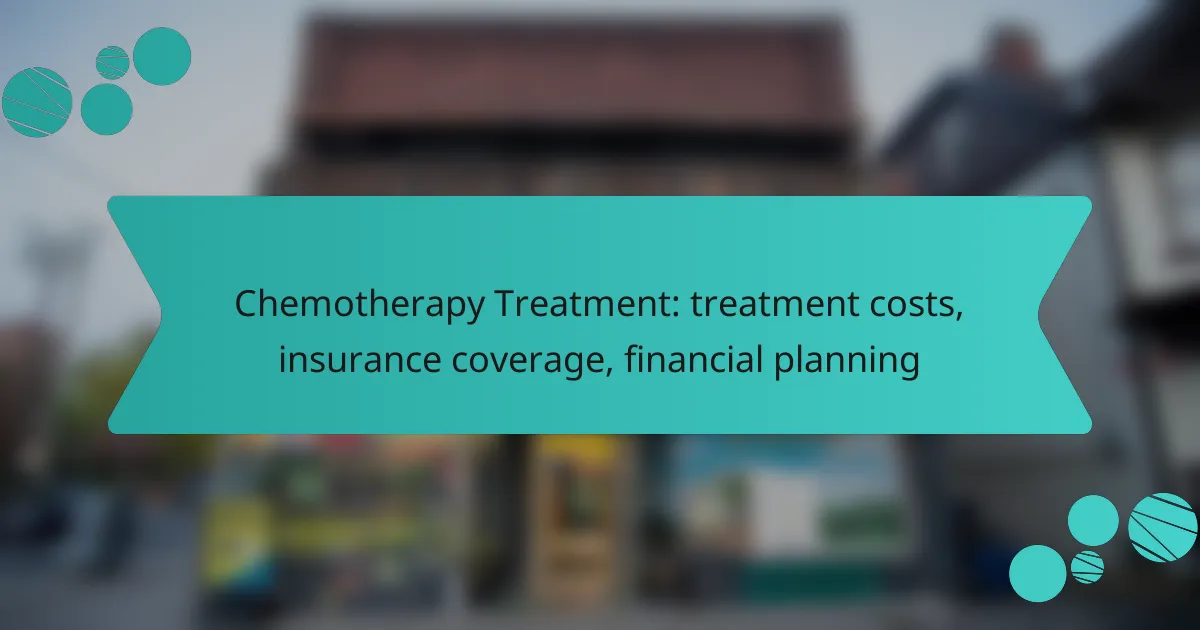Chemotherapy treatment costs in Canada can vary widely, influenced by factors such as cancer type, treatment regimen, and geographic location, often ranging from thousands to tens of thousands of dollars. Insurance coverage typically combines public and private health plans, which can significantly affect out-of-pocket expenses and access to medications. Effective financial planning is essential, and patients can explore government assistance programs, non-profit support, and hospital financial aid to help manage the costs associated with chemotherapy.

What are the costs of chemotherapy treatment in Canada?
The costs of chemotherapy treatment in Canada can vary significantly based on several factors, including the type of cancer, treatment regimen, and location. Generally, patients may face expenses ranging from thousands to tens of thousands of Canadian dollars, depending on their specific circumstances.
Average treatment costs
On average, chemotherapy treatment in Canada can cost between CAD 10,000 and CAD 30,000 for a complete course. This range typically includes the price of medications, administration, and associated medical services. Some patients may incur additional costs for supportive care and follow-up appointments.
It is essential to consult with healthcare providers to obtain a more accurate estimate based on individual treatment plans and needs.
Factors affecting costs
Several factors influence the costs of chemotherapy treatment, including the type of cancer, the specific drugs used, and the treatment duration. Personalized treatment plans may lead to higher costs if specialized medications or advanced therapies are required.
Additionally, the healthcare facility’s location and its associated fees can also affect overall expenses. Urban centers may have different pricing structures compared to rural clinics.
Cost variations by province
Costs for chemotherapy treatment can differ by province due to variations in healthcare funding and provincial health plans. For example, provinces like Ontario and British Columbia may have different coverage policies and drug formularies, impacting out-of-pocket expenses.
Patients should check with their provincial health authority to understand specific coverage options and any potential costs they may incur. This ensures informed financial planning and helps in navigating the healthcare system effectively.

How does insurance coverage work for chemotherapy?
Insurance coverage for chemotherapy typically involves a combination of public and private health plans that help offset treatment costs. Understanding the specifics of your insurance can significantly impact out-of-pocket expenses and access to necessary medications.
Types of insurance plans
There are generally two main types of insurance plans: public health insurance and private health insurance. Public plans, often provided by the government, cover a range of medical services, including chemotherapy, while private plans may offer additional benefits or faster access to treatments.
Public health insurance varies by province or state, affecting coverage levels and eligibility. Private insurance plans can differ widely in terms of premiums, deductibles, and out-of-pocket maximums, so it’s crucial to review the details of each plan.
What is covered under provincial health plans?
Provincial health plans typically cover the costs of chemotherapy drugs administered in hospitals, as well as some outpatient treatments. Coverage may include physician fees, hospital stays, and necessary diagnostic tests.
However, not all chemotherapy drugs are covered, especially newer or experimental treatments. Patients should check with their provincial health plan to understand which specific medications and services are included and any potential co-pays or limits.
Private insurance options
Private insurance can supplement public health plans by covering additional costs such as outpatient chemotherapy drugs, alternative therapies, or travel expenses for treatment. These plans often provide more flexibility in choosing healthcare providers and accessing specialized care.
When considering private insurance, evaluate the coverage limits, exclusions, and waiting periods. It’s advisable to compare different policies and consult with an insurance advisor to find the best fit for your healthcare needs and financial situation.

What financial planning options are available for chemotherapy?
Financial planning for chemotherapy involves exploring various resources to manage treatment costs effectively. Patients can access government assistance programs, support from non-profit organizations, and financial aid offered by hospitals to alleviate the financial burden of chemotherapy.
Government assistance programs
Government assistance programs can provide crucial financial support for chemotherapy treatments. In the United States, programs like Medicaid and Medicare offer coverage for eligible patients, which can significantly reduce out-of-pocket expenses. It’s essential to check eligibility requirements and apply as soon as possible to ensure timely access to these benefits.
In some countries, national health services may cover a portion of chemotherapy costs, depending on the treatment type and patient circumstances. Researching local regulations and available programs can help patients maximize their financial assistance options.
Non-profit organizations supporting patients
Numerous non-profit organizations offer financial aid and resources for patients undergoing chemotherapy. Organizations like the Leukemia & Lymphoma Society and CancerCare provide grants, co-pay assistance, and emotional support to help patients manage treatment costs. These resources can be invaluable in navigating the financial challenges of cancer care.
Additionally, many non-profits have specific eligibility criteria and application processes, so patients should gather necessary documentation and apply early to secure funding. Connecting with local support groups can also provide insights into additional resources available in the community.
Financial aid from hospitals
Many hospitals offer financial aid programs to assist patients with chemotherapy costs. These programs may include sliding scale fees based on income, payment plans, or assistance with insurance claims. Patients should inquire about financial assistance options when scheduling treatment to understand what support is available.
It’s important to communicate openly with hospital financial counselors about your situation. They can help identify potential resources and guide you through the application process for any available aid, ensuring you receive the necessary support during treatment.

What are the prerequisites for starting chemotherapy?
Before starting chemotherapy, patients must undergo specific evaluations and meet certain eligibility criteria. These prerequisites ensure that the treatment is safe and appropriate for the patient’s individual health status.
Medical evaluations required
Patients typically need to complete a series of medical evaluations before beginning chemotherapy. These may include blood tests to assess organ function, imaging studies to determine cancer stage, and a thorough physical examination. The results help oncologists tailor the treatment plan to the patient’s needs.
Common tests include complete blood counts (CBC), liver function tests, and kidney function tests. Depending on the type of cancer, additional tests like CT scans or MRIs may be necessary to evaluate the extent of the disease.
Patient eligibility criteria
Eligibility for chemotherapy often depends on several factors, including overall health, cancer type, and previous treatments. Oncologists assess whether the patient can tolerate chemotherapy based on their medical history and current health status.
Key criteria include the patient’s age, presence of other medical conditions, and performance status, which measures how well they can perform daily activities. Patients with severe comorbidities may need alternative treatments or supportive care instead of chemotherapy.

How can patients manage chemotherapy side effects?
Patients can effectively manage chemotherapy side effects through a combination of medication, lifestyle adjustments, and support systems. Understanding common side effects and employing specific strategies can significantly enhance comfort and quality of life during treatment.
Common side effects and management strategies
Common side effects of chemotherapy include nausea, fatigue, hair loss, and changes in appetite. To manage nausea, patients may benefit from anti-nausea medications prescribed by their healthcare provider, along with dietary adjustments like eating small, frequent meals. Staying hydrated is also crucial.
Fatigue can be addressed through gentle exercise, proper rest, and balanced nutrition. Patients should listen to their bodies and prioritize sleep while engaging in light activities, such as walking, to maintain energy levels. Hair loss can be managed with the use of wigs or head coverings, which can provide comfort and confidence.
Support resources available in Canada
In Canada, patients undergoing chemotherapy can access various support resources, including financial assistance programs and counseling services. Organizations like the Canadian Cancer Society offer information on managing side effects and connecting with support groups.
Additionally, provincial health services may provide resources for mental health support and nutritional guidance. Patients are encouraged to speak with their healthcare team about available local resources that can aid in managing side effects effectively.

What are the emerging trends in chemotherapy treatment?
Emerging trends in chemotherapy treatment focus on enhancing effectiveness and accessibility while reducing costs. Innovations in personalized medicine, the rise of telehealth, and future cost predictions are reshaping how patients receive care.
Advancements in personalized medicine
Personalized medicine tailors chemotherapy based on individual genetic profiles, improving treatment efficacy and minimizing side effects. This approach often involves genetic testing to identify specific mutations in tumors, allowing for targeted therapies that are more effective than traditional methods.
For example, drugs like trastuzumab are used specifically for breast cancers that overexpress the HER2 protein. As research progresses, more targeted options are becoming available, potentially leading to better outcomes and fewer adverse reactions.
Impact of telehealth on treatment accessibility
Telehealth has significantly improved access to chemotherapy consultations and follow-ups, especially for patients in remote areas. Virtual appointments reduce the need for travel, making it easier for patients to receive ongoing care and support.
Moreover, telehealth can facilitate quicker adjustments to treatment plans based on patient feedback, enhancing overall care. Patients are encouraged to utilize telehealth services to maintain regular communication with their healthcare providers.
Future cost predictions for chemotherapy
Future cost predictions for chemotherapy indicate a potential decrease in expenses due to advancements in treatment options and increased competition among drug manufacturers. As more biosimilars enter the market, prices for certain chemotherapy drugs may drop, making treatment more affordable.
Patients should be aware of their insurance coverage, as policies can vary widely. It is advisable to consult with financial advisors or insurance representatives to understand potential out-of-pocket costs and explore assistance programs that may be available.
